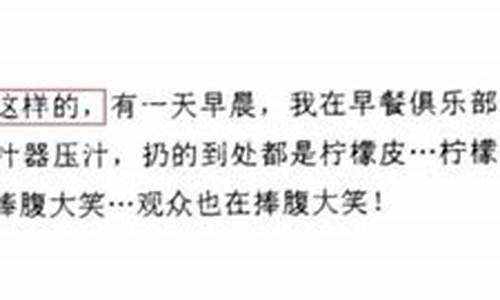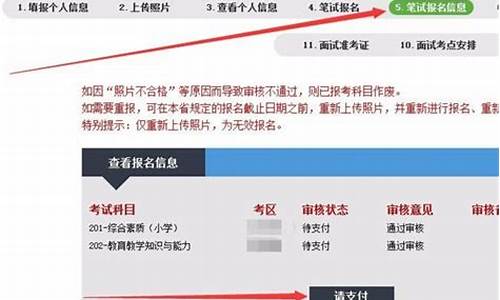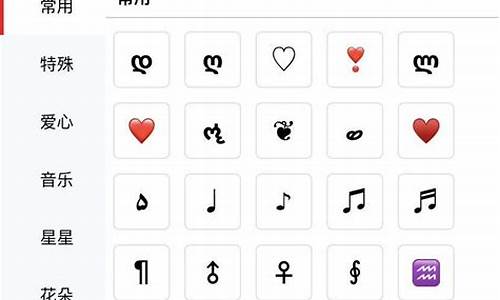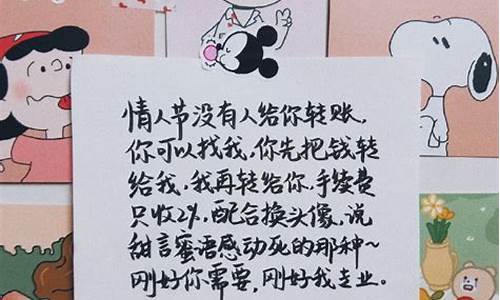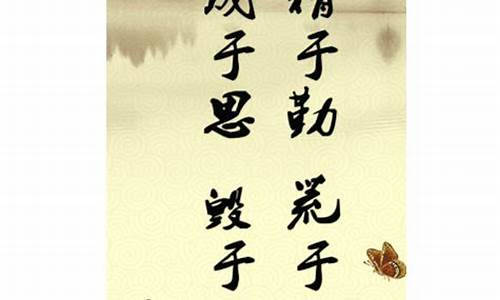您现在的位置是: 首页 > 经典语录 经典语录
英语的句子结构口诀_英语的句子结构讲解是什么
tamoadmin 2024-08-18 人已围观
简介1.英语句子的结构2.英语句子的组成部分的解析3.精通英语的帮我仔细分析一下这句英文的句子结构和语法!高分4.可悬赏5到10分(英语)什么是句子结构,都有什么结构,怎么判断。谢谢。5.英语句子的基本结构是什么?6.英语句子成分5个:1. 主语+谓语(不及物动词) [S + V] 2. 主语+谓语(及物动词)+宾语 [S+V+O] 3. 主语+谓语+表语 [S+V+P] 4. 主语+谓语+间接宾语+
1.英语句子的结构
2.英语句子的组成部分的解析
3.精通英语的帮我仔细分析一下这句英文的句子结构和语法!高分
4.可悬赏5到10分(英语)什么是句子结构,都有什么结构,怎么判断。谢谢。
5.英语句子的基本结构是什么?
6.英语句子成分

5个:
1. 主语+谓语(不及物动词) [S + V]
2. 主语+谓语(及物动词)+宾语 [S+V+O]
3. 主语+谓语+表语 [S+V+P]
4. 主语+谓语+间接宾语+直接宾语 [S+V+InO+DO]
5. 主语+谓语+宾语+宾语补足语 [S+V+O+OC]
英语句子的结构
英语句子看上去纷繁庞杂,但仔细观察不外乎五个基本句式。这五个基本句式在不同的时态、语态下,可以演变出多种复杂的英语句子,换言之,绝大多数英语句子都是由这五个基本句式生成的。这五个基本句式如下:S十V主谓结构; S十V十O主谓宾结构; S十V十F主系表结构; S十V十O1+ O2 主谓双宾结构;S十V十O十C 主谓宾补结构.说明:S=主语;V=谓语;P=表语;O=宾语;O1=间接宾语;O2=直接宾语;C=宾语补足语五个基本句式详细解释如下:1 .主谓型:S十V句式
在此句式中,V是不及物动词,又叫自动词(vi.)。例如:
He runs quickly.他跑得快。
They listened carefully.他们听得很仔细。
He suffered from cold and hunger.他挨冻受饿。
China belongs to the third world country.中国属于第三世界国家。
The gas has given out.煤气用完了。
My ink has run out.我的钢笔水用完了。2.主谓宾:S十V十O句式
在此句式中,V是及物动词(vt.),因此有宾语。例如:
I saw a film yesterday. 我昨天看了一部**。 He you read the story? 你读过这个故事吗?
They found their home easily. 他们很容易找到他们的家。They built a house last year. 他们去年建了一所房子。They've put up a factory in the village. 他们在村里建了一座工厂。
They he taken good care of the children. 这些孩子他们照看得很好。
You should look after your children well. 你应该好好照看你的孩子。3.主系表:S十V十P句式
在此句式中,V是系动词(link v.)常见的系动词有:(1):be-am/is/are/was/were (我用am你用are,is连着他、她、它);(2):感官动词:sound,look, smell,taste,feel;(3):变得---: get,turn ,become, grow等;(4):其它:go(bad/unpunished); fall (ill/asleep); stand/sit (still),remain(weak). seem,ear,等。例如:
He is older than he looks. 他比看上去要老。
He seems interested in the book. 他似乎对这本书感兴趣。
The story sounds interesting. 这个故事听起来有趣。
The desk feels hard. 书桌摸起来很硬。
The cake tastes nice. 饼干尝起来很香。
The flowers smell sweet and nice.花闻起来香甜。
You he grown taller than before.你长得比以前高了。
He has suddenly fallen ill. 他突然病倒了。
He stood quite still. 他静静地站看。
He becomes a teacher when he grew up.他长大后当了教师。
He could never turn traitor to his country.他永远不会背叛他的祖国。注意:有些动词同时也是及物动词,可构成SVO句式,例如:He looked me up and down.他上下打量我。
They are tasting the fish.他们在品尝鱼。
They grow rice in their home town.他们在家乡种水稻。
He's got a chair to sit on.他有椅子坐。
Please turn the sentence into English.请把这个句子译成英语。4.动词加双宾: S十V十O1十O2句式
在此句式中,V是带有双宾语(间接宾语/直接宾语)的及物动词。常见的须带双宾语的动词有give,ask,bring,offer,send,pay,lend,show,tell,buy,get;rob,warn等。例如:He ge me(间接宾语)a book(直接宾语)/a book to me.他给我一本书。
He brought me a pen/a pen to me. 他带给我一枝钢笔。
He offered me his seat/his seat to me. 他把座位让给我。注意下边动词改写后介词的变化:
Mother bought me a book/a book for me. 妈妈给我买了一本书。
He got me a chair/a chair for me. 他给我弄了一把椅子。
Please do me a for/a for for me. 请帮我一下。He drew a picture for me. 他画张画给我
He asked me a question/a question of me.他问我一个问题。
注意,下边动词只有一种说法:
They robbed the old man of his money. 他们抢了老人的钱。
He's warned me of the danger. 他警告我注意危险。
The doctor has cured him of his disease. 医生治好了他的病。
We must rid the house of the rats. 我们必须赶走屋里的老鼠。
5. 宾语补语: S十V十O十C句式
在此句式中,V是有宾语补足语的及物动词,如: see; hear; hear; he; let; consider; ask; tell; advise等。 常带宾语补足语的词有形容词、副词、介词短语、名词、不定式、现在分词、过去分词;常见的可接宾语补足语的动词很多,哪些动词可接哪几种形式作宾补,
须根据动词的惯用法而定,不能一概而论,请看下面的例子。They made the girl angry.他们使这个女孩生气了。
They found her hy that day.他们发现那天她很高兴。
I found him out.我发现他出去了。
I saw him in.我见他在家。
They saw a footprint in the sand.他们发现沙地上有脚印。
They named the boy Charlie.他们给这个男孩起名查理。
I saw him come in and go out.我见他进来又出去。
They felt the car moving fast.他们感到汽车行驶得很快。
I heard the glass broken just now.我刚才听到玻璃碎了。
He found the door of study closed to him.他发现研究所的大门对他关闭了。英语句子分为简单句、并列句和复合句单句结构要牢记,复句注意关、连词关连词分为关系词(关系代词或关系副词:Wh---/how---)和连词(并列连词(and/or/but)和其它连词because/although/as if/so/however/weather/if等。不管英语的复句多长、多复杂,去掉关、连词后,它还是简单句结构!
英语句子的组成部分的解析
呵呵,我还在上小学呢。
主语:是一个句子的主体,表示所说的对象是"谁"或"什么",由代词、名词、相当于名词的短语来充当。
例:The
boy
is
listening.(The
boy为主语)
谓语:说明主语的动作、行为、特征或状态,一般由动词来充当。
例:I
beat
him.(beat为谓语)
宾语:谓语动词所表示的动作所涉及的对象或介词所支配的对象,由名词、代词、短语或从句来充当。
例:I
like
her
very
much.(her为宾语)
表语:系动词后所跟的名词、形容词、代词、副词或从句。
系表结构:This
story
is
very
interesting.(is为系动词
interesting为表语)
That's
what
I
said.('s为系动词
what
I
said为表语)
定语:用来修饰名词或代词,充当定语的有形容词、名词、短语从句。
例:a
beautiful
girl(beautiful是形容词,充当定语
girl是名词,被修饰的)
状语:一般表示行为发生的时间、地点、目的、方式、程度等,常用来修饰动词、副词或整个句子。
例:With
a
smile
on
his
face,
he
went
out.(With
a
smile
on
his
face为方式,做这个句子的状语)
I
will
go
with
you
if
it
doesn't
rain.(if
it
doesn't
rain为设,这句是条件状语从句)
精通英语的帮我仔细分析一下这句英文的句子结构和语法!高分
Different parts of a sentence概念句子是由词按照一定的语法结构组成的.组成句子的各个部分叫做句子的成分.句子的成分包括:主语、谓语、表语、宾语(直接和间接宾语)、宾语补足语、定语和状语.主语和谓语是句子的主体部分(在英语中,一般句子必须有主语和谓语),表语、宾语和宾语的补足语是谓语里的组成部分.其他成份如定语和状语是句子的次要成分.▲句子成分分类1.主语 主语是谓语讲述的对象,表示所说的“是什么”或“是谁”.一般由名词、代词、不定代词或相当于名词的单词或短语来充当,也有从句充当的现象.大多数主语都在句首.如:讲述“谁”We work in a big factory. 讲述“什么”The classroom is very big. 数词作主语Three are enough. 三个人就够了不定式作主语To operate on the blind is one of the ORBIS Doctor’s job.从句作主语What we need is food. 我们最需要的是食物.▲ 在“There be …”句型中,主语的位置在中间.如:There are some bottles of milk in the box.▲ 在个别句型中,主语在整个句子后面,这时前面用it作形式主语.如: It is very interesting to play the game called “treat or trick”. It took two workers about three months to build the house.2.谓语谓语时用来说明主语“做什么”、“是什么”或“怎么样”,谓语必须是动词,谓语和主语在“人称”和“数”两方面必须一致.如:He is very generous.She looks very smart and coolWe he finished the job.He can speak German.3.表语 表语说明主语“是什么”或“怎么样”,由名词、形容词、介词、副词、不定式及相当于名词的词或短语来充当,它的位置在系动词后面. 形容词作表语You look younger than before. 名词作表语 My father is a teacher. 副词作表语Everyone is here.介词短语作表语They are at the theatre.不定式作表语My job is to teach them English.动名词作表语Her job is training the nurses.从句作表语That is why he didn’t come to school yesterday.4.宾语▲宾语是动作、行为的对象,由名词、代词、不定式、或相当于名词的词或短语或从句来充当,它和谓语动词一起说明主语是什么,通常放在谓语动词后面.有时,会有双宾语.如:名词作宾语He never forgives others for their mistakes.代词做宾语He often helps me.不定式作宾语He likes to sleep in the open air.动名词作宾语The Americans enjoyed living in China.从句做宾语I believe that they can finish the work in time.▲直接宾语和间接宾语及物动词作谓语时,后面要跟宾语,宾语分直接宾语和间接宾语.直接宾语是及物动词的对象.但有些动词除了直接宾语外,还需要有一个间接宾语,间接宾语表语动作是对谁做的,所以只能用名词或代词来充当.如:We brought them some food.主 谓 间宾 直宾间接宾语可以放在直接宾语后面,但必须加to 或 for.5.宾语的补足语 在英语的句子中有些句子里只有宾语并不能表达完整的意思,还必须在宾语后面加上宾语的补足语才能表达完整的意思.我们把“宾语+宾语补足语”合起来称为复合宾语.复合宾语所表达的意思相当于一个巨资的意思.名词、动词、形容词、副词、介词短语、不定式、现在分词、过去分词都可以作宾语补足语.如:名词作宾补If you let me go, I’ll make you king.形容词作宾补Don’t make your hands dirty.副词作宾补We found Li Ming out when we arrived.介词短语作宾补Make yourself at home.省略to的不定式作宾补I saw a girl go into the building.带to的不定式作宾补The boy ordered the dog to lie down.现在分词作宾补The boss kept them working all day.过去分词作宾补Yesterday he got his leg broken.在英语中,常见的“宾语+宾语补足语”的结构有:▲“宾语+名词”.常用于改结构的动词有:call, name, make, find, choose, think, lee等. We call him Jack. They made Li Lei their monitor.▲“宾语+形容词”.常见的动词有think, believe, lee, drive, make, keep, turn, wish, want等.如:Do you think his idea wrong?We must keep our classroom clean.We can’t lee him alone.Can you get everything ready for the party before Friday?▲“宾语+副词”.副词作宾补常表示宾语的状态,与宾语有逻辑上的主表关系.常见的副词有:down, up, here, there, home, in, out, anywhere等.如: Let him in/ out. Mr. Li drove us home.When got there, we found him out.▲“宾语+介词短语”.介词短语作宾补常表示其逻辑主语(即宾语)所处的状态,两者有主表的关系.如: We found everything in good order. We regard him as our good friend.He opened the door and found some of his friends in the rain.▲“宾语+不定式”.充当宾补的不定式有三种: A 要求带to的不定式The cool water of the lake invited us to swim. B 要求不带to 的不定式 let, make, see, hear, watch等 The boss made the workers work 12 hours a day. I often hear him read English in his room. C 单词help 后可加 to 或不加 to She sometimes helps her mother (to) do housework.▲“宾语+现在分词”.现在分词作宾补,此时在该句型中的宾语即为现在分词逻辑上的主语,有着主谓关系. I saw them playing on the playground.I heard Mary singing in the classroom.▲“宾语+过去分词”.宾语和宾补之间是被动关系,过去分词表示被动和完成. I had my bike stolen. The teacher explained again and again to make himself understood.▲ 形式宾语+形容词 We found it impossible to get there before Saturday.▲宾语+what 从句Call me what you like.Mr. Li has made the factory what it is today.The mountain village is different from what it was ten years ago.6.定语▲ 定语用来修饰名词或代词.形容词、代词、数词、名词、介词短语、不定式或相当于形容词的词或短语等都可以充当定语.因为它是修饰名词或代词的,而名词和代词可以作主语、表语或宾语,所以定语的位置很灵活,凡是有名词、代词的地方都可以有定语.如: 形容词作定语 The black bike is mine. 代词作定语 What’s your name?名词作定语They made some paper flowers.介词短语作定语 The boys in the room are in Class Three, Grade One.不定式作短语 I he lots to eat and drink.从句作定语 The tall boy who is standing there is Peter.▲ 在英语中,并不是所有的定语都放在被修饰词的前面,有的是放在被修饰词的后面,故称“后置定语”.▲ 修饰不定代词 something, anything, nothing, something, anyone, somebody, anybody, nobody 的定语必须后置.如: We’ll go to he something English. If you don’t know the answer, ask someone else. Do you he anything important to tell me?▲介词短语作定语时要后置.如: Do you know the boy behind the tree?
The students in the room are all my friends. I think the picture on the left is better than the one on the right.▲动词的不定式作定语时要后置 What about something to drink? I he no time to trel to China is in Autumn or in Spring.注 动词不定式作主语时,to 后面的动词必须是及物动词或相当于及物动词的短语.如果时短语时,那么与动词搭配的介词或副词是不能少的. Do you he any piece of music to listen to? ▲nearby, below, downstairs等个别方位词作定语时要后置.如:We are at the top of the hill. Can you see the village below?The people downstairs are listening to a talk now?They took the boy to the hospital nearby at once.7.状语 状语用来修饰动词、形容词或副词.它表示行为发生的时间、地点、目的、方式、程度等,一般由副词、介词短语、不定式,从句或相当于副词的词或短语来充当.状语一般放在句末,但有时也可以放在句首、句中.如: He did it carefully They missed me very much. Without his help, we couldn’t work it out. In order to catch up with my classmates, I must study hard. When I was young, I could swim well.
可悬赏5到10分(英语)什么是句子结构,都有什么结构,怎么判断。谢谢。
句子的基本结构
一、句子的基本成分
句子的基本成分有以下几种:主语、谓语、宾语、表语、定语、状语、补语、同位语。
1、主语:句子的主体,全句述说的对象。一般由名词、代词、不定式、动名词或从句担当,位于句首。
The boy needs a pen.
Smoking is bad for you.
2、谓语:说明主语的动作或状态。由动词或系动词加表语担任,常置于主语后。
The train lees at 6 o’clock.
She is reading.
3、宾语:表示动作的对象。一般由名词或代词担当,常置于谓语后。
He won the game.
He likes playing computer.
4、表语:用以表述主语的特征、状态、身份等。一般由名词或形容词担任,置于系动词之后。
He is a student.
We are tired.
注意:除了be 系动词外,还有一些动词也可以用作系动词,
1)表感官的动词: feel, smell, taste, sound, look, ear, seem 等。
2)表转变变化的动词: become, get, grow, turn, go等。
3)表延续的动词: remain, keep, hold, stay, rest等。
5、定语:对名词或代词起修饰、限定作用的词、短语或句子。
The black bike is mine.(形容词)
The boy in blue is Jim.(介词短语)
I he nothing to do today.(动词不定式)
注意:1、当定语修饰不定代词如:nothing , anything , everything , something 等时,定语要放在其后作后置定语。例如: I tell him something interesting.
2、不定式、短语或从句作定语时,也放在被修饰的名词之后。例如:
The boys who are in the room are playing games.
6、状语:用以修饰adj. /v. /adv.及全句,位置灵活。
1、修饰形容词或副词时,通常位于被修饰的词之前;
I am very sorry.
2、表示时间、地点、目的的状语一般位于句子两头,强调时放在句首。
In order to cheer him up, I told him the truth.
They are writing English in the classroom.
3、一些表示不确定时间(如:often)或程度(如:almost)的副词状语通常位于be动词、助动词、情态动词之后,动词之前。
We often help him.
He is always late for class.
7、补语:补充说明宾语的情况。由n./adj./介宾/分词/不定式等担任。常位于宾语后。
He made me sad.(形容词)
She asks me to take an umbrella.(不定式)
The war made him a soldier.(名词)
I find him at home.(介词短语)
I saw a cat running along the wall.(分词)
8、同位语:同位语是句子成分的一种, 它位于名词、代词后面, 说明它们的性质和情况, 它可以由名词、代词、名词性短语或从句充当。
Tom, our monitor, is a handsome boy.
I myself will do the experiment.
She is the oldest among them six.
二、句子的基本分类
1、按使用目的,句子可分为陈述句、疑问句、祈使句和感叹句。
1)陈述句:说明一个事实或陈述一种看法。例如:
Light trels faster than sound. 光比声传播速度快。(说明事实)
The film is rather boring. 这部**很乏味。(说明看法)
2)疑问句:提出问题。有以下四种:
a. 一般疑问句:
Can you finish the work in time?
b. 特殊疑问句:
Where do you live?
c. 选择疑问句:
Do you want tea or coffee?
d. 反意疑问句:
He doesn't know her, does he?
3)祈使句:提出请求,建议或发出命令。例如:
Don't be nervous!
4)感叹句:表示说话人惊奇、喜悦、愤怒等情绪。例如:
What good news it is!
2、按其结构,句子可以分为以下三类:
1)简单句:只包含一个主谓结构句子叫简单句。例如:
She is fond of collecting stamps.
2)并列句:包含两个或两个以上主谓结构的句子叫并列句,句与句之间通常用并列连词或分号来连接。例如:
The food was good, but he had little etite.
3)复合句:包含一个主句和一个或几个从句的句子叫复合句,从句由从属连词引导。例如:
The film had begun when we got to the cinema.
三、句子的基本结构
1、简单句
1. Things changed.
2. Trees are green.
3. We don’t like children.
4. He ge his sister a piano.
5. I found the book interesting.
2、并列句
This is me and these are my friends.
They must stay in water, or they will die.
It’s not cheap, but it is very good.
It was late, so I went to bed.
四、句子的扩写
1. The children played.
Lots of lovely children from China played hily in the park this morning.
2. The boy lent me a book.
The kind boy in blue coat lent me a very interesting book several days ago, and I love it so much.
句子的基本结构综合训练
一、指出下列划线部分的基本成分。
1. Our school is not far from my home.
2. It is a great pleasure to talk with you
3. All of us considered him honest.
4. Grandma told me an interesting story last night.
5. Her job is to look after the babies.
6. We need a place twice larger than this one.
7. He goes to school by bike.
8. The man over there is my old friend.
9. What he needs is a book.
10. I must lee right now.
二、指出下列句子属于哪种基本句子结构。
1. My grandfather bought me a pair of sports shoes.
2. He broke a piece of glass.
3. He asked us to sing an English song.
4. We will make our school more beautiful.
5. Trees turns green in spring.
6. He came finally last night.
7. Her voice sounds sweet.
8. The meeting will be held in the meetingroom.
9. Mary handed her homework to the teacher.
10. He made it clear that he would lee the city.
三、写出下列句子。
1、她学习很努力。
2、我昨天早上遇见了Lily。
3、五年前我住在北京。
4、你必须在两周以内看完这些书。
5、布朗夫人看起来很健康。
6、这个主意听起来很有趣。
7、我爸爸上个月给我买了一辆崭新的自行车。
8、他的父母给他取名为John。
9、这个学校有一名音乐老师和一名美术老师。
10、我认为他聪明又有趣。
四、扩展下列句子。
1. I went to school.
2. I got a book.
3. He left.
英语句子的基本结构是什么?
英语中有五大句子结构:
1)主系表结构(主语+联系动词,也叫 Be 动词+表语),例如:I am a student(我是个学生).
2)主谓结构(主语+谓语),例如:I work(我工作) I sleep(我睡觉).
3)主谓宾结构(主语+谓语+宾语),例如:I study English(我学习英语).
4)主谓双宾结构:(主语+谓语+2个宾语),例如:She ge me an le.(给我一个苹
果),其中 She 是主语,ge 是谓语,me 和 le 都是宾语,所以称作双宾语。双宾语可
以转换成:She ge an le to me.
5)主谓宾加宾补结构:(主语+谓语+宾语+宾语补足语),例如:I see a girl dancing.(我看见
一个女孩在跳舞),dancing(跳舞)是动名词做宾语补足与,与宾语有主谓关系。
英语句子成分
英语句子的基本结构
1、主语+谓语(不及物动词)
2、主语+谓语(及物动词)+宾语
3、主语+谓语+表语
4、主语+谓语+间接宾语+直接宾语
5、主语+谓语+宾语+宾语补足语
例句:
1、The children are playing hily。
翻译:孩子们正在高兴地玩。
2、The Greens enjoy living in China。
翻译: 格林一家喜欢住在中国。
3、The le tastes really delicious。
苹果吃起来真是好吃。
4、I passed him the salt。
翻译:我把盐递给他。
5、The accident hened yesterday evening。
翻译:事故是昨天晚上发生的。
在英文当中,有八大句子成分,分别是:主语、谓语、宾语、表语、定语、补语、同位语、状语。
主语:动词的发出对象
谓语:动词
宾语:动词的承受对象
表语:说明主语的品质、性质、身份、特征和状态,通常在系动词(be/become/feel/sound/turn...)后面
定语:用来修饰、描述主语或宾语,形容词通常做定语
补语:用来补充说明主语或宾语
同位语:即“同等位置”,以一个名词来解释说明另外一个名词或代词。
状语:表示时间、地点、原因、目的、结果、方式、程度等,副词通常做状语。
扩展资料:
举例:
1、 My sister Susan sings very well.
我的妹妹苏珊唱歌很棒。
My—定语
sister—主语
Susan—同位语
sings—谓语
very well—状语
2、She is Chinese.
她是中国人。
She—主语
is—be动词
Chinese—表语
3、I painted the wall white.
我把墙漆成白色的。
I—主语
painted—谓语
the wall—宾语
white—补语



